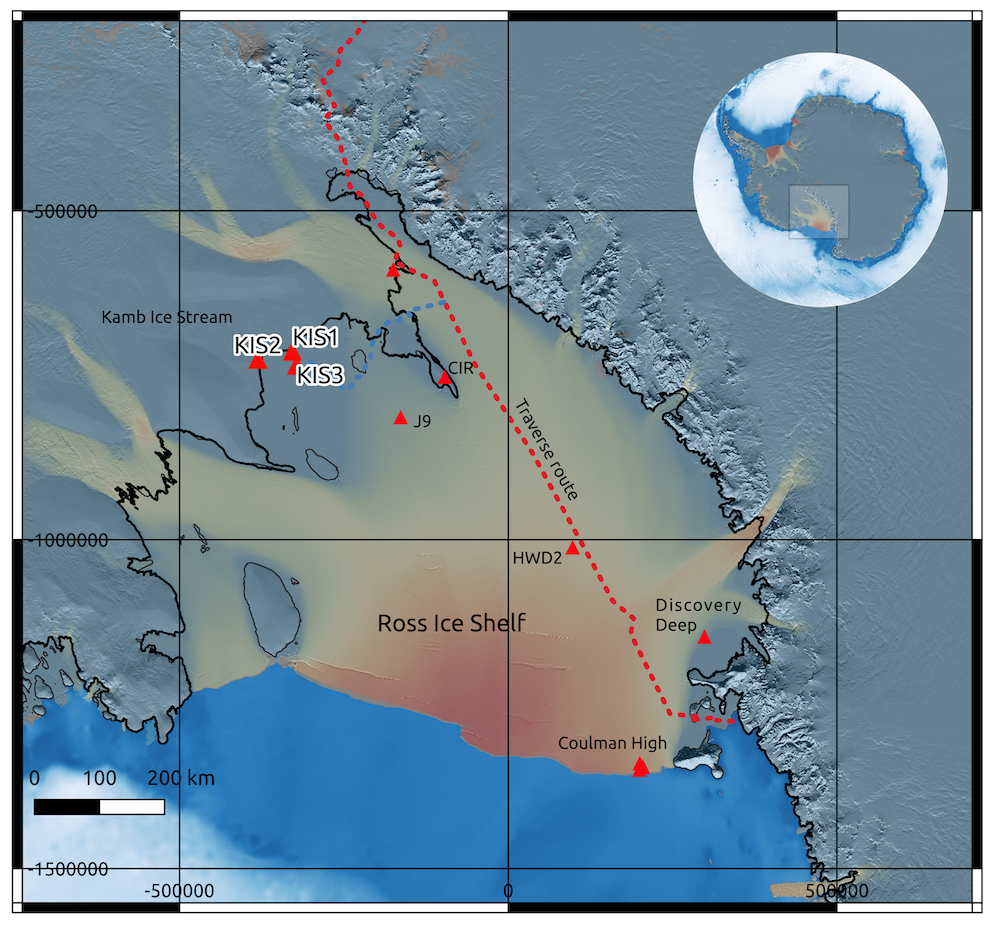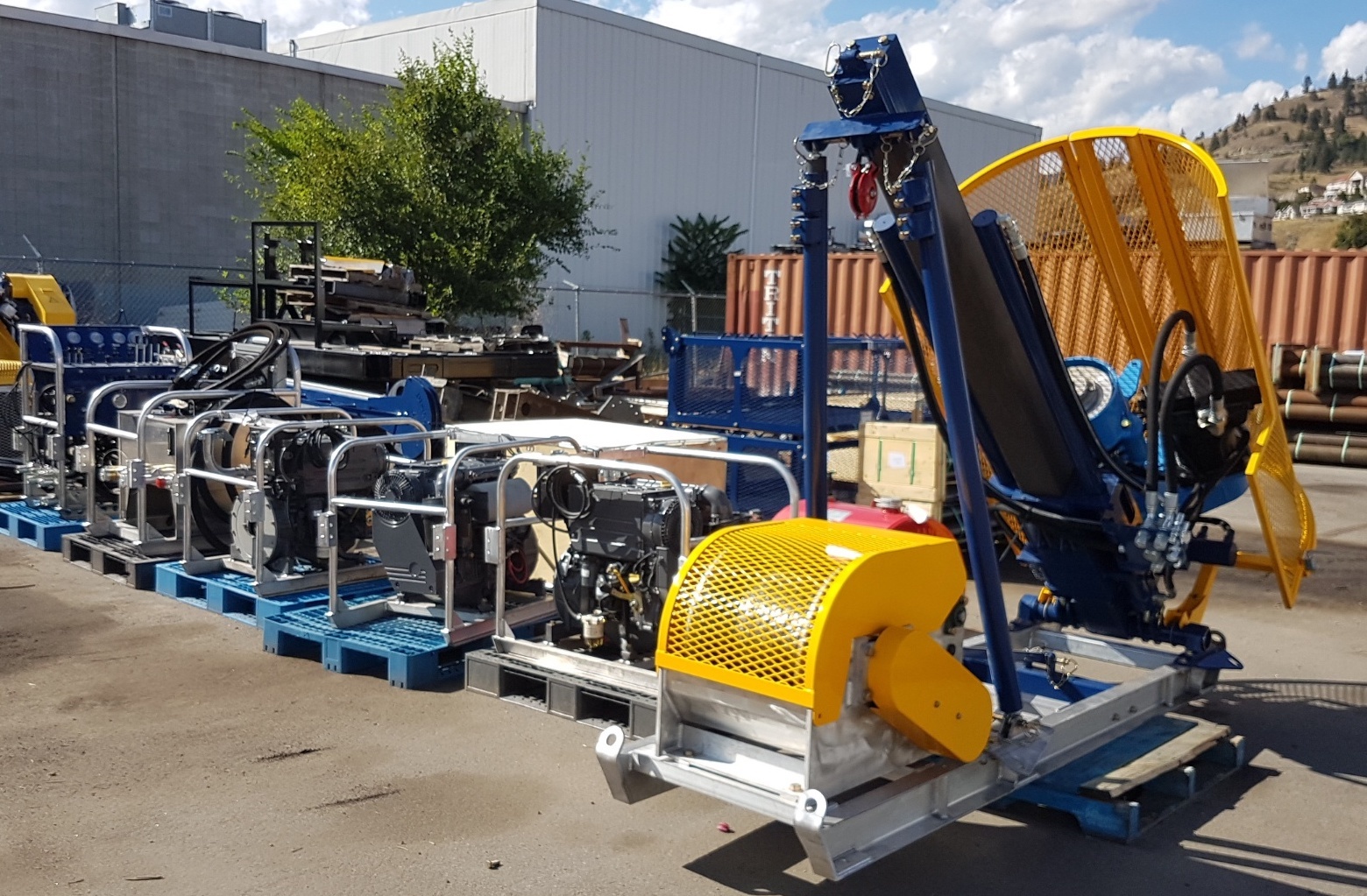
Ice and Sediment Drilling System
This bespoke, intermediate-depth geological drilling system will enable us to access the ocean cavity beneath the Ross Ice Shelf, and to recover rock and sediment core from the ocean floor. The system is capable of working in a combined ice and water column thickness of up to 1000 metres, and can obtain a sedimentary core up to 200 metres long.
Why?
Valuable archives of past climate and ice sheet behaviour can be found in ice and sediment records. Scientific drilling and core recovery provides information on past temperature, precipitation, atmospheric composition, volcanic activity, and even wind patterns. These data are used to reconstruct past climate conditions and ice sheet behaviour, and to inform Antarctica’s future response to climate change.
Antarctic ice sheet (AIS) dynamics remain the largest uncertainty in projections of future sea level rise. In particular, the response of the West Antarctic Ice Sheet (WAIS) to projected warming remains a significant uncertainty in sea level rise projections. The WAIS is presently losing mass at an accelerating rate. It holds enough ice, if melted, to contribute 4.3 metres to global sea level.
One critical knowledge gap is understanding the timing of past WAIS collapses and the environmental conditions that caused complete retreat in past warmer-than-present climatic conditions.
We are embarking on an ambitious drilling and research programme with international collaborators (See Project 1: Ice Dynamics and SWAIS 2C) to obtain this sedimentary history at two locations, Kamb Ice Stream and Crary Ice Rise, near the modern grounding zone of the WAIS, along the Siple Coast in the West Antarctic interior.

Ross Ice Shelf drilling sites (red) including the Antarctic Science Platform sites at Kamb Ice Stream (KIS) and Crary Ice Rise (CIR). Additional sites show previous New Zealand led drilling locations at HWD2, and Coulman High as well as the international programmes as J9 and Whillans Ice Stream. The Discovery Deep site has been proposed and is the subject of ongoing site characterisation.
Ice and Sediment Drilling System
Accessing the geological archives beneath the ice shelf requires a system able to operate in remote locations, drill through around 1000 metres of ice, pass through the ocean cavity (withstanding currents and salinity), and then accurately sample the poorly consolidated glacial sediments in the upper ~200 metres below the sea-bed. A new, specialised drilling system was needed.

3D concept diagram of the drill system operating through the ice shelf. The drilling system must drill through around 1000 metres of ice, pass through the ocean cavity (withstanding currents and salinity), and then accurately sample sediments in the sea floor below the ice. Credit: GNS Science.
Large drilling systems, including the ANDRILL rig, used to acquire long geological ice core records, cost substantial amounts to deploy to remote locations. Smaller gravity and percussion coring systems cost less to deploy, but cannot penetrate over compacted (hard) diamictites that were deposited across the Ross Sea during the last glacial maximum.
Our engineers have developed a bespoke ice and sediment drilling system, integrating a Hot Water Drill (copied from a British Antarctic Survey design, and developed for previous projects ), and an Antarctic Intermediate Depth Sediment Drill (designed for this research). This transportable system is capable of recovering ~200 metres of sediment in places where the combined depth of the ice shelf (or sea ice) and water column is over 1000 metres thick.
The Hot Water Drill (HWD) is used to melt a hole through the Ross Ice Shelf to allow access to the sea floor. A kilometre-long hose uses hot-water jets from a nozzle to “drill” through the ice. The pilot hole is then reamed wider to about 30cm and maintained throughout the drilling season. Winches are able to send down scientific equipment, for sampling the water column and surface sediments, and to deploy oceanographic instruments.
The sediment drill uses the hot water drill hole and is designed to fit in the existing HWD drilling tent, and where possible shares water and heating resources with the HWD. The sediment rig comprises a modified diamond coring system, light weight sea riser, drill string, and bottom hole assembly with hydraulic piston coring and rotary coring tools. In total, the system weighs ~30 tonnes or less, depending on the length of drill pipe required. The system can be broken down into modules that can be transported by sled, plane or helicopter.
On site, a customised winch is needed to set up the well-pump assembly and lower instrumentation into the drill hole.

The intermediate depth sediment drill (foreground, right) and accompanying hydraulic pumps and power packs (lined up to the left of drill) at the manufacturer’s site. Credit: Multi Power Products
Deployment
Heavy equipment travels down to Antarctica by ship, and then a convoy of heavy-tracked vehicles traverses the ice shelf, towing tonnes of equipment to the drilling site, over 1000 kilometres from Scott Base. The deep field traverse for this programme required a new overland route to be mapped and tested, which occurred during the summer seasons of 2017-18 and 2018-19.
Geophysical surveys have been carried out to locate the ‘best’ drilling location. In the summer of 2019-2020, the team used the hot water to drill 600 metres through the ice shelf at the Kamb Ice Stream site. An ocean mooring was deployed in the cavity below that will take continuous measurements over the coming years.
The hot water drill system was again used during the 2021-2022 season, when it accessed a large subglacial drainage channel emerging from beneath the West Antarctic Ice Sheet into the ice shelf ocean cavity.
The sediment drill is currently undergoing final modifications and testing prior to its deployment to Antarctica, with the first anticipated drilling planned for the 2023-2024 summer season.

Lowering the borehole well pump during the 2021/2022 Kamb Ice Stream drilling program. Photo: Craig Stevens